One of the leading animation and Vfx education providers, Maya Academy of Advanced Cinematics successfully conducted Maac Manifest in Mumbai on Saturday, 15 September 2012 with the presence of over 900 plus students from Maac and recognized industry stalwarts.
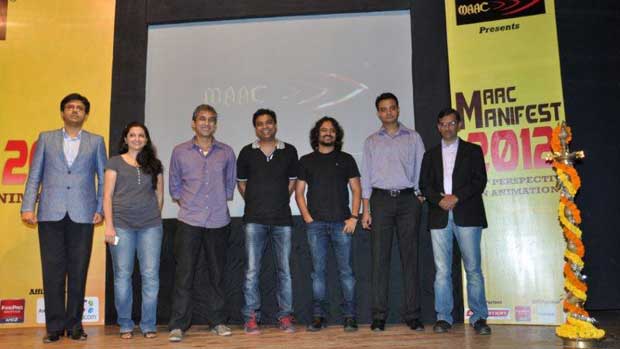
The vision of Maac with this event was to inform students about the latest trends in the industry and take students through the effort taken behind making animated movies.
Maac Manifest was graced with renowned faces of Industry, Arnab Chaudhuri, Creator of Arjun the Warrior Prince is currently the creative director at Walt Disney Television International, Arpan Gaglani, Creative Director at Krayon Pictures and Kirtish Tharthare, Lead Lighting Artist at Rhythm & Hues Studios.
The overall event was divided into interesting sessions by these industry stalwarts, which included behind the scenes of Arjuna the Warrior Prince, A Brief about Delhi Safari, the upcoming movie of Krayon Pictures and Behind the Scenes of X-Men First Class and Yogi Bear.
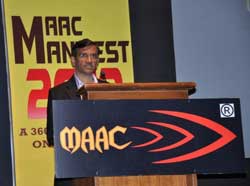 At the successful completion of MAAC Manifest in Mumbai, Mr. Ram Warrier, Business Head, MAAC said, “We have entered the 3D Age and this is clearly visible from the kind of animated movies being created both in terms of quality and quantity. Through the Manifest event, we planned to educate and create awareness about the ample job opportunities that the animation sector provides in designing, VFX, etc. We are amazed at the response and believe that with a crowd of more than 900 students at the seminar, confidence in the sector is here to stay.”
At the successful completion of MAAC Manifest in Mumbai, Mr. Ram Warrier, Business Head, MAAC said, “We have entered the 3D Age and this is clearly visible from the kind of animated movies being created both in terms of quality and quantity. Through the Manifest event, we planned to educate and create awareness about the ample job opportunities that the animation sector provides in designing, VFX, etc. We are amazed at the response and believe that with a crowd of more than 900 students at the seminar, confidence in the sector is here to stay.”
Arnab, in his session, took the audience through the initial sketches of Arjuna and focused on character design and production design approach in for making Arjuna the Warrior Prince.
He interestingly shared the names and pictorial descriptions of Bollywood and Hollywood stars that were used as reference for creating the characters of the movie.
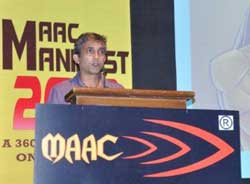 Coming to the production design approach for Arjuna, Arnab said that the team took references of famous landscapes and architectures of India. Sketches of historical places Panchala, Hastinapur, Indraprasth, along with the inspirational sketches and the first composited shot of the movie were shown to the audience. According to Arnab, a classical 2D look was given to this movie to ease the production process and save time for making the movie. Also, Arnab shared that all the painting aspects in the movie were digitally executed using Wacom Tablets.
Coming to the production design approach for Arjuna, Arnab said that the team took references of famous landscapes and architectures of India. Sketches of historical places Panchala, Hastinapur, Indraprasth, along with the inspirational sketches and the first composited shot of the movie were shown to the audience. According to Arnab, a classical 2D look was given to this movie to ease the production process and save time for making the movie. Also, Arnab shared that all the painting aspects in the movie were digitally executed using Wacom Tablets.
For sure! The attendees must have a good time with the making of Arjuna, but this was not all! The event was then taken ahead by Kirtish Tharthare, who highlighted the working style and policies at Rhythm and Hues and also screened the studio’s showreel. He made
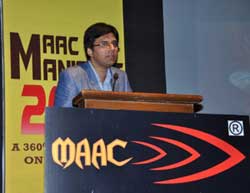 an interesting point and that was to include proper skill set section in one’s CV. Speaking about the making of X-Men First Class, Kirtish showcased the making of crucial shots done by R & H, which were Emma Frost Converting into a Diamond, Transformation of Mystique. In the overall session, he emphasized on the need of planning a particular scene well by differentiating between the elements to be kept in live action and the ones to be kept in CGI. He followed this with the making of Yogi Bear in which 2D artworks; Facial Expressions of Yogi Bear were shown. Kirtish focused on using turn tables for 3D characters for checking the flaws in the mesh flow, lighting setup and texturing. Also, Kirtish spoke about the growth of Vfx technology in which he advised the student crowd to keep themselves updated with the latest software knowledge.
an interesting point and that was to include proper skill set section in one’s CV. Speaking about the making of X-Men First Class, Kirtish showcased the making of crucial shots done by R & H, which were Emma Frost Converting into a Diamond, Transformation of Mystique. In the overall session, he emphasized on the need of planning a particular scene well by differentiating between the elements to be kept in live action and the ones to be kept in CGI. He followed this with the making of Yogi Bear in which 2D artworks; Facial Expressions of Yogi Bear were shown. Kirtish focused on using turn tables for 3D characters for checking the flaws in the mesh flow, lighting setup and texturing. Also, Kirtish spoke about the growth of Vfx technology in which he advised the student crowd to keep themselves updated with the latest software knowledge.
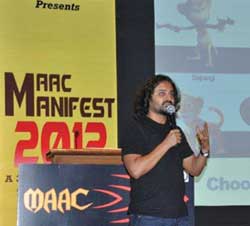 With the making of the works done by R & H, came the next session by Arpan Ganglani, which on focused on Delhi Safari by Krayon Pictures, releasing on October 19 this year.
With the making of the works done by R & H, came the next session by Arpan Ganglani, which on focused on Delhi Safari by Krayon Pictures, releasing on October 19 this year.
In the session, Arpan threw light on the pre-production, production and post-production processes of of Delhi Safari. He disclosed that the movie’s script took around four months to complete and the entire film was enacted before getting into detailed production. He pointed out that it took four months to complete the storyboarding with only two artists on board.
Arpan introduced the audience to the characters of Delhi Safari and described the traits and uniqueness of each character with showcasing the 2D animatics. A realistic yet stylized look was given to all the characters, with Alex being the most challenging.
He revealed that a group of artists simulated a journey from Borivali National Park (in Mumbai) to Delhi (the same journey the animals take in the film) so that they could collect all the references of the places they travelled and roll these into Delhi Safari’s production.
